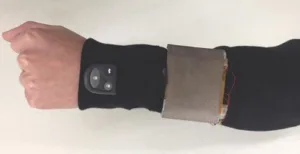A team at Korea’s Sungkyunkwan University is working on a wearable, portable charging solution with a difference.
Rather than tapping into excess kinetic energy or solar power, the researchers have developed a new fabric that utilises static electricity. The material is made of two layers of fabric: one of silver-coated fibres and the other containing 100nm zinx oxide nanorods, coated with polydimethylsiloxane (a type of silicon).
When a wearer moves, the layers rub together, creating a positive charge on one side and a negative charge on the other – generating static. The nanorods increase the contact area between the layers, leading to greater friction and power output. When the materials are separated, a weak electric current is formed.
A 4cm² piece of the new material produced an output of 120V and a current of 65µA, under a compressive force of 10kgf. Without the nanopatterning, the same material produced 30V and 20µA. Four stacked layers produced an output of 170V and 120µA. There were no significant differences in output voltage over 12,000 cycles.
In tests, the 4cm² patch of cloth was attached to a jacket sleeve and used to power six embedded LEDs, a small LCD and a keyless car remote inside the jacket, one at a time.
The material could not, in its current state, be used to power a smartphone, but could be paired with a battery pack to store power. The research was published in the journal ACS Nano (http://tinyurl.com/kg2obra).

